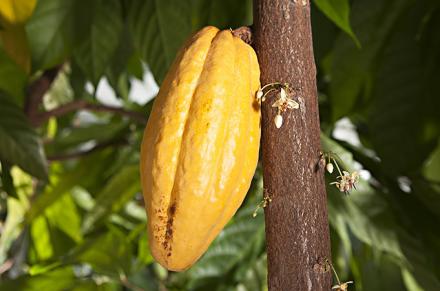ARS Research + Persistence = Cacao of Highest Yield and Quality

The small island of Puerto Rico once had a thriving cacao industry, with plantations and businesses centered on products made from cacao beans. Those days appeared to have been long past, but a long-term project is now bearing fruit in a big way.
Disparate factors, including hurricanes and changing economic conditions, had taken a toll on cacao production since the 1700s. Then, nearly 40 years ago, USDA’s Agricultural Research Service (ARS) joined the effort to return cacao production to the island. Puerto Rico is now one of the top producers (per hectare) in the world.
According to Luz Serrato, plant pathologist at the ARS Tropical Agriculture Research Station (TARS) in Mayaguez, Puerto Rico, the worldwide average for cacao production is 400 kg (about nearly 882 pounds) of dried beans per hectare (about 2.5 acres ); Puerto Rico’s farmers produce 2,000 kg (about 4,409 pounds) per hectare.
In 1986, ARS scientists conducted experiments to identify cacao plants that were suitable for Puerto Rico's soil and climate. The researchers used trees from five cacao families from Costa Rica and then evaluated them at various locations around Puerto Rico for several years. The 40 best-producing trees were grafted onto “EET-400” rootstock (that is resistant to Ceratocystis fimbriata, a soil-borne disease of cacao); and then performance-tested at Corozal, PR, for several more years. Finally, researchers selected the nine best cacao trees and released planting materials from them to farmers.
“The research was groundbreaking given the limitations of genomic tools at the time, which were in their early stages and not widely affordable for targeted marker-assisted selection,” Serrato said. “This rigorous approach culminated in the release of the TARS trees, which outperform the global yield average manyfold.”
In addition to much greater yield, the cacao beans are more highly rated in “organoleptic” tests. These tests show how consumers rate the sensory aspects of flavor, odor, appearance, and mouthfeel of a food or drink product. A group of chocolate experts conducted the tests, including Seguine Cacao Cocoa and Chocolate Advisors (Hanover, PA), and the Guittard Chocolate Company (Burlingame, CA).
“This combination of agronomic and quality traits ensured that the selected trees were not only productive but also met standards for chocolate production,” Serrato said.
Each year, more farmers in Puerto Rico are adopting cacao as one of their crops, reflecting the growing interest in its cultivation. While Puerto Rico may not currently rank among the world’s top cacao producers in terms of volume, the high quality of its cacao positions it as a potential leader in premium cacao production.
“These trees represent a significant advancement in cacao research and serve as a model for sustainable and high-performing agricultural systems,” Serrato said. “They are a testament to the quality of ARS research.” – by Scott Elliott, ARS Office of Communications

